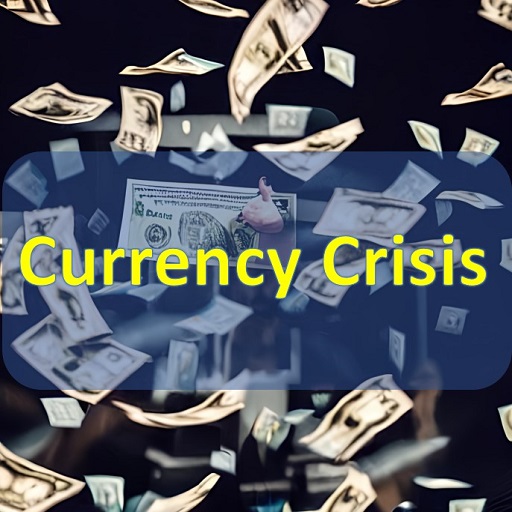A currency crisis refers to a sharp and sudden depreciation in the value of a country’s currency. When a currency crisis occurs, it can have significant impacts on the foreign exchange (forex) market and various aspects of the economy. Here are some of the effects of a currency crisis on forex and potential solutions to address them:
Exchange Rate Volatility
During a currency crisis, exchange rates can become highly volatile, making it difficult for businesses and individuals to predict and plan for future transactions. This volatility creates uncertainty and risk in the forex market, impacting trade and investment flows.
Solution
Central banks can intervene in the forex market by buying or selling their currency to stabilize exchange rates. Additionally, implementing monetary and fiscal policies that address the underlying economic issues causing the crisis can help restore confidence and stability.
Reduced Foreign Investment
Currency crises often lead to a loss of investor confidence in the affected country, resulting in a decrease in foreign direct investment (FDI). This decline in investment can further weaken the currency and hinder economic growth.
Solution
Governments can implement measures to attract foreign investment, such as improving the business environment, providing incentives for investors, and promoting economic reforms to address the root causes of the crisis. Building a transparent and stable regulatory framework can help restore investor confidence.
Capital Flight
During a currency crisis, there is a risk of capital flight, where investors and individuals transfer their funds out of the country in anticipation of further currency devaluation. This outflow of capital can exacerbate the crisis and put additional pressure on the currency.
Solution
Governments can implement measures to control capital flight, such as imposing capital controls or introducing policies to encourage repatriation of funds. However, such measures should be carefully calibrated to avoid excessive restrictions that could harm economic activity or discourage foreign investment in the long term.
Trade Imbalances
Currency crises can disrupt international trade by affecting the competitiveness of exports and imports. A sharp depreciation in the domestic currency can make imports more expensive, leading to inflationary pressures, while exports may become more competitive but could also face challenges due to uncertainties and disruptions in global markets.
Solution
Governments can implement policies to promote export diversification, enhance competitiveness, and support domestic industries. This may involve providing export subsidies, improving infrastructure, investing in research and development, and entering into trade agreements to access new markets.
Debt Burden
Currency crises can increase the burden of foreign-denominated debt for countries. When the domestic currency depreciates, the cost of servicing and repaying foreign debt rises, putting strain on the government’s finances.
Solution
Governments can work with international financial institutions to negotiate debt restructuring or seek assistance in managing the debt burden. Implementing sound fiscal policies, improving debt management practices, and fostering economic growth can also help alleviate the debt burden over time.
Speculative Attacks
Currency crises can attract speculators who seek to profit from the devaluation of a currency. Speculative attacks, such as short-selling a currency, can further exacerbate the depreciation and create a vicious cycle of selling pressure.
Solution
Central banks can defend their currency through interventions in the forex market and by implementing measures to discourage speculative activities. This may include increasing interest rates to make the currency more attractive to investors or implementing regulations to limit speculative trading.
Confidence and Sentiment
Currency crises can significantly impact market confidence and investor sentiment. Prolonged periods of instability can erode trust in the affected currency and the overall economy, leading to a prolonged recovery process.
Solution
Governments and central banks can communicate effectively to restore confidence and provide reassurance to the market. Transparency in policymaking, clear communication of reform initiatives, and proactive measures to address the underlying economic issues can help rebuild confidence over time.
International Cooperation
Currency crises can have spillover effects on other countries and regions, particularly in interconnected global markets. The interconnectedness of financial systems means that a crisis in one country can quickly spread to others.
Solution
International cooperation and coordination among governments, central banks, and international financial institutions are crucial in managing currency crises. Cooperation can involve sharing information, coordinating policy responses, providing financial assistance, and promoting stability in the global financial system.
Structural Reforms
Currency crises often expose underlying structural weaknesses in an economy, such as fiscal imbalances, unsustainable debt levels, inadequate regulatory frameworks, or weak financial institutions. Addressing these fundamental issues is essential to prevent future crises.
Solution
Governments can undertake structural reforms to address the root causes of the crisis. This may involve fiscal consolidation, improving governance and transparency, strengthening financial regulation and supervision, and enhancing the resilience of the banking sector. These reforms can help build a more robust and sustainable economic foundation.
Diversification of Reserves
Currency crises highlight the importance of having a well-diversified reserve portfolio. Excessive reliance on a single currency or a narrow range of assets can increase vulnerability to external shocks.
Solution
Governments and central banks can diversify their foreign exchange reserves by holding a mix of currencies and assets. This can include a combination of major currencies, commodities, and other stable and liquid financial instruments. Diversification can help mitigate risks associated with individual currencies and provide a buffer during times of crisis.
It’s important to note that the effectiveness of proposed solutions may vary depending on the specific circumstances of each currency crisis and the underlying economic conditions. Additionally, the implementation of these solutions requires careful consideration of their potential short-term and long-term consequences, as well as coordination among various stakeholders involved.
Currency crisis in Iran
Iran has faced several currency crises in its recent history, largely driven by economic sanctions, political instability, and structural imbalances within its economy. These crises have had significant impacts on the country’s forex market and overall economy. Here are some key points regarding currency crises in Iran:
Economic Sanctions
Iran has been subject to extensive international sanctions due to concerns over its nuclear program and other geopolitical issues. These sanctions have limited Iran’s access to the global financial system, restricted its ability to engage in international trade, and hindered foreign investment. As a result, the country has experienced severe currency devaluations and forex market disruptions.
Depreciation of the Rial
The Iranian Rial (IRR) has experienced significant depreciation during currency crises. In recent years, the value of the Rial has declined sharply against major foreign currencies, leading to high inflation and increased costs of imported goods.
Inflationary Pressures
Currency devaluation and restricted access to international markets have contributed to inflationary pressures in Iran. The rising costs of imports, including essential goods and commodities, have had a direct impact on the cost of living for Iranian citizens.
Black Market Currency Trading
Due to the limited availability of foreign currencies in the official forex market, a significant portion of forex transactions in Iran occurs through the informal or black market. This has led to discrepancies in exchange rates, further complicating the forex market and contributing to economic instability.
Capital Flight and Limited Foreign Investment
Currency crises in Iran have resulted in capital flight, as individuals and businesses seek to protect their wealth by moving assets out of the country. Additionally, the lack of economic stability and investment opportunities has deterred foreign investors from entering the Iranian market.
Addressing currency crises in Iran requires a comprehensive approach involving both domestic and international measures. Some potential solutions and initiatives include:
Economic Reforms
Implementing structural reforms to address fiscal imbalances, improve governance, promote transparency, and diversify the economy away from oil dependency can help restore stability and confidence.
Diversification of Exports
Encouraging non-oil exports can reduce reliance on oil revenues and help improve the country’s foreign exchange earnings. This may involve supporting and promoting sectors such as manufacturing, agriculture, and services.
Access to Global Financial System
Engaging in diplomatic negotiations and addressing international concerns can potentially lead to the easing or removal of economic sanctions. Restoring Iran’s access to the global financial system would facilitate trade, foreign investment, and currency stability.
Central Bank Intervention
The Central Bank of Iran can intervene in the forex market to stabilize exchange rates, manage liquidity, and address excessive volatility. This may involve buying or selling foreign currencies or implementing monetary policy measures to regulate the money supply.
Strengthening Financial Institutions
Enhancing the resilience and transparency of domestic financial institutions can contribute to a more stable forex market. This includes improving risk management practices, regulatory frameworks, and banking sector oversight.
International Support
Engaging with international financial institutions, such as the International Monetary Fund (IMF), can provide technical assistance, financial support, and guidance in implementing necessary reforms and stabilizing the economy.
It’s important to note that the specific solutions and their effectiveness in addressing currency crises in Iran may vary based on the complex geopolitical and economic dynamics involved. The successful resolution of currency crises requires a coordinated effort among various stakeholders, including the government, central bank, private sector, and international partners.
The impact of the currency crisis on the people of Iran
Currency crises in Iran have had significant impacts on the people of the country, affecting various aspects of their daily lives and overall economic well-being. Here are some key ways in which the currency crisis has affected the people of Iran:
Inflation and Rising Cost of Living
Currency devaluation during a currency crisis leads to a surge in inflation. As the value of the Iranian Rial (IRR) declines, the prices of imported goods and essential commodities increase, making it more expensive for people to afford basic necessities such as food, fuel, and medicine. This rise in the cost of living puts a strain on household budgets, particularly for low-income individuals and families.
Reduced Purchasing Power
The depreciation of the currency diminishes the purchasing power of the Iranian people. As the value of the Rial decreases, it becomes more difficult for individuals to afford imported goods and foreign travel. People may also face challenges in accessing quality imported products, as their affordability becomes increasingly limited.
Unemployment and Economic Instability
Currency crises can lead to economic instability, which in turn can result in job losses and reduced employment opportunities. Businesses may struggle to operate amidst the economic uncertainty and currency fluctuations, leading to layoffs and closures. This can contribute to higher unemployment rates and increased financial hardship for individuals and families.
Capital Flight and Savings Erosion
During currency crises, there is often a significant outflow of capital as individuals and businesses seek to protect their assets by moving them out of the country or converting them into foreign currencies. This capital flight can erode personal savings and investments, further exacerbating financial insecurity for the people of Iran.
Access to Foreign Goods and Services
As the currency crisis limits access to foreign currencies and restricts international trade, it becomes more challenging for individuals in Iran to access a wide range of foreign goods and services. This can impact lifestyle choices, travel options, and availability of certain products, potentially reducing the quality of life for some segments of the population.
Social Welfare and Government Spending
Currency crises can strain government finances, limiting the resources available for social welfare programs, public services, and infrastructure development. Reductions in government spending on education, healthcare, and social support can have negative consequences for the well-being and livelihoods of the population.
It’s important to note that the impacts of currency crises on the people of Iran can vary depending on individual circumstances, socioeconomic factors, and the severity and duration of the crisis. The most vulnerable segments of society, such as low-income individuals and those heavily reliant on imported goods, tend to bear the brunt of the effects. Government policies, social safety nets, and international support can play a role in mitigating the adverse impacts and helping to alleviate the hardships faced by the people during currency crises.







